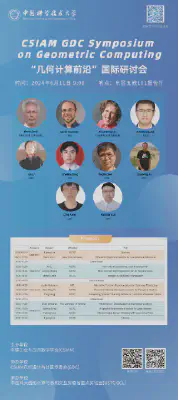GCL学术活动:举办“几何计算前沿”国际研讨会
会议简介
2024年6月11日,由中国工业与应用数学学会(CSIAM)主办、CSIAM几何设计与计算专委会(GDC)协办、中国科学技术大学安徽省图形计算与感知交互重点实验室(GCL实验室)承办的“几何计算前沿”国际研讨会在中国科学技术大学东区第五教学楼5101举行。研讨会由CSIAM GDC专委会主任、GCL实验室主任刘利刚老师组织,邀请了国外三位著名学者(美国纽约大学的Denis Zorin教授、美国麻省理工学院的Justin Solomon教授、以及加拿大多伦多大学的Eitan Grinspun教授)和 GCL 实验室的七位年轻教师作学术报告。120余名校内外师生参加了此次研讨会。
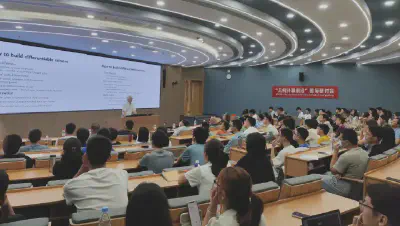
报告介绍
在开场致辞环节,刘利刚老师首先携在场师生热烈欢迎远道而来的三位国际学者;然后介绍了本次研讨会的背景:旨在分享最新尖端成果和研究方向,内容涵盖细分曲面,形状分割,三角化,可展曲面逼近,共性参数化,三维配准和重建,数字人建模,物理仿真,计算制造和机械系统等,是学习和交流国内外计算机图形学历史积淀,最新发展和未来方向的非常难得的机会;最后,简要介绍了研讨会的程序安排,并期待与会者能在研讨会与讲者们积极交流并能够收获满满。
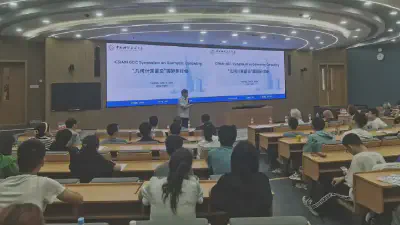
报告1: Differential physical simulation for computational fabrication
来自美国纽约大学的 Denis Zorin 教授主要研究方向是几何建模和科学计算等。在报告中,他首先介绍了可微仿真的概念和实现方法,提出使用含高阶时间积分的有限元方法来高效求解物理对象对任意参数(如形状,材料参数,摩擦因数,边界条件等)的梯度,最后他展示了他们团队利用可微仿真的方法,在几何形状优化,微结构优化和气压传动装置优化三个问题上的创新工作。
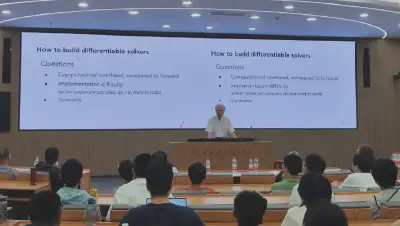
报告2: Non-uniform subdivision: recent development
来自 GCL实验室的李新老师主要研究方向是计算机辅助几何设计与建模,等几何分析等。在报告中,他先回顾了曲面细分方法的两个基本要点,包括特征性质是细分的主要研究问题,和 DFT 是研究该问题的基础工具。在前人工作的基础上,他提出了利用解反特征值等思路来提升几何质量和降低非均匀细分误差的方法。
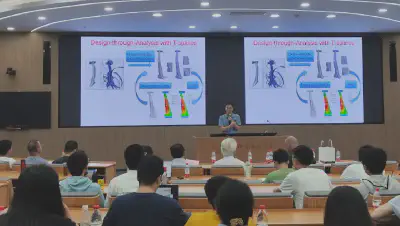
报告3: Rigid and Non-rigid Registration for 3D Reconstruction
来自 GCL实验室的张举勇老师主要研究方向是三维视觉,计算机图形学和机器学习。在报告中,他从三维重建中物体配准的背景和挑战讲起,依次介绍了他们针对传统 ICP 算法进行改进以提高鲁棒性和收敛速度,基于对称点到平面的距离提升非刚性配准的准确性与鲁棒性,和基于神经隐式表示及逆向渲染实现端到端非刚性重建的工作。
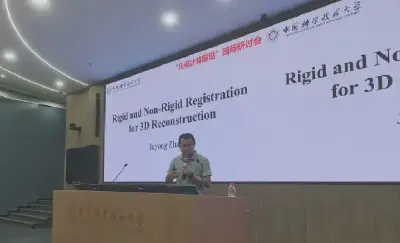
报告4: Parallel 3D Delaunay Triangulation
来自 GCL实验室的陈仁杰老师主要研究方向是几何处理与建模,计算机图形学等。在报告中,他首先介绍了近年来重心坐标及其应用的发展情况,接着重点介绍了他们团队在曲边 cage 的多项式柯西坐标、参数曲面的光栅渲染器和利用 GPU 加速并行生成三维 Delaunay 三角化的研究工作,最后他进一步展望了在非均匀输入和含约束情况下的三角化研究方向。

报告 5: Alternative Function Representations for Geometry Processing
来自美国麻省理工学院的Justin Solomon 教授主要研究方向是几何处理和优化等。在报告中,他首先介绍了几何处理中常见的优化问题(如曲面参数化,形状变形等),引出了其中比较典型的计算难题(如优化速度慢,易陷入局部极小值等)。接下来他从凸问题和非凸问题两个方面,以多个模型问题(如 skining weights, barycentric coordinates 等)为例,详细阐释了近年来学界对这些问题的研究工作。
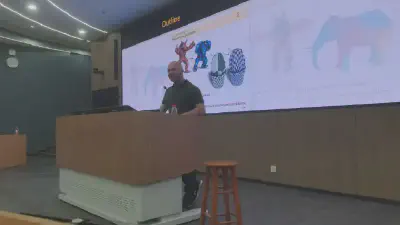
报告6: Piecewise Developable Approximations for Triangular Meshes
来自 GCL实验室的傅孝明老师主要研究方向是几何处理与优化,三维制造等。在报告中,他报告了用可展曲面减少制造成本的研究工作:首先介绍了用分割和优化的方法得到分片可展曲面的方法,然后详细讲解了使用遗传算法的改进方法,并展示了用纸片(可弯成任意可展曲面)实际制造的若干例子。
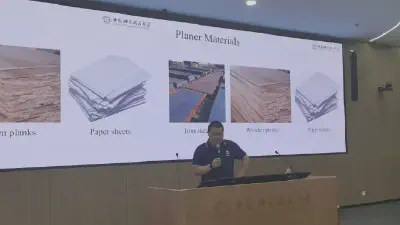
报告7: Generating Sparse Cone Singularities for Conformal Parameterizations
来自 GCL实验室的方清老师主要研究方向是几何处理,共形几何和三维制造等。在报告中,他报告了共性参数化中一类特殊问题,即生成锥奇异点的问题。他先介绍了利用 ADMM 算法优化 L0 能量得到无整数约束的稀疏锥奇异点的工作,其次说明了它在降低面积扭曲和过分割中的应用,最后介绍了含整数约束的稀疏优化方法。
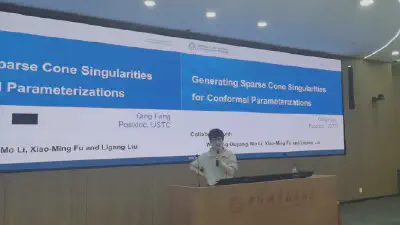
报告8: Adventures in Discretization of Mechanical Systems
来自加拿大多伦多大学的 Eiten Grinspun 教授主要研究方向是计算动力学。在报告中,他从宇宙中天体运行的规律出发,引出了用计算机模拟机械系统的基本观点,然后他以 Germain’s 弯曲能量等问题为例,阐释了数学计算的重要性。最后他借用图形学中若干实际问题,进一步说明了在现代计算机中,如何用离散的方式来表示和求解连续几何与物理问题,以及不依赖离散输入的计算模拟方法。
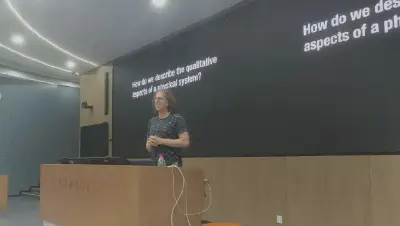
报告 9: A Spectral Segmentation Method for Large Meshes
来自 GCL实验室的童伟华老师主要研究方向是计算机辅助几何设计和计算机图形学。在报告中,他报告了三维网格分割问题。他首先介绍了分割问题的目标和困难,并回顾了近年来的最新研究,提出大网格的分割问题仍具有相当大的挑战。针对该问题,他介绍了他们的多分辨率形状表示,特征感知简化及快速映射和由测地线曲率驱动的曲线演变等方法。

报告10: Efficient Digital Human Modeling with Generative Priors
来自 GCL 实验室的郭玉东老师主要研究方向是计算机图形学和三维视觉。在报告中,他介绍了数字人建模的最新进展,且就真实性,效率和可编辑性三个方面,分别介绍了有关数字人的最新研究工作。

在会议期间,与会者与各讲者展开了热烈的学术讨论,并对各自的问题给予了详细的解答。研讨会所有报告结束后,刘利刚老师对研讨会进行了简短的总结,对各位讲者表示衷心的感谢,并希望未来能够继续保持交流与合作。在热烈的掌声中,本次研讨会圆满结束。

讲者介绍

Denis Zorin, New York University, USA
Denis Zorin is Silver Professor of Computer Science and Mathematics and the Chair of the Computer Science Department at the Courant Institute of Mathematical Sciences. Prior to joining Courant, he was a postdoc at Stanford University, and completed his PhD thesis at California Institute of Technology. Denis’s primary interests span the domains of geometric modeling, geometry processing and scientific computing. His main contributions are in the theory and practical algorithms for subdivision surfaces, efficient algorithms for deformation and parameterization, meshing, computational methods for integral equations, and computational fabrication. His awards include ACM Fellow, SIGGRAPH Computer Graphics Achievement Award and SIGGRAPH Academy membership, ACM Gordon Bell Prize, Sloan Foundation Fellowship, NSF Career award, and several IBM Partnership awards. He served on many program committees and editorial boards, and his former students and postdocs hold faculty positions at many universities, including Stanford, University of Toronto, University of Texas and University of Michigan.
Justin Solomon, MIT, USA
Justin Solomon is an Associate Professor of Electrical Engineering and Computer Science and a member of the Computer Science and Artificial Intelligence Laboratory (CSAIL) at MIT, where he leads the Geometric Data Processing Group. Prior to joining the MIT faculty, Solomon was an NSF Mathematical Sciences Postdoctoral Research Fellow in Princeton’s Program in Applied and Computational Mathematics. He received his PhD in computer science from Stanford University in 2015, where he also received an MS in computer science (2012) and a BS in mathematics and computer science (2010). During his PhD, Solomon was supported by the National Defense Science and Engineering Graduate Fellowship (NDSEG), the Hertz Fellowship, and the NSF Graduate Research Fellowship Program (GRFP). Solomon also has worked at Pixar Animation Studios (2007-2012) and MITRE Corporation (2005-2007). His textbook Numerical Algorithms covers numerical methods for geometry, graphics, robotics, and other computational applications.
Eiten Grinspun, University of Toronto, Canada
Eitan Grinspun is Associate Chair, Academic Recruiting at the Department of Computer Science at the University of Toronto, where he is also a Professor of Computer Science and Mathematics. He was previously the Director of the Columbia Computer Graphics Group at Columbia University (2004–2021), Professeur d’Université Invité at l’Université Pierre et Marie Curie in Paris (2009), a Research Scientist at New York University’s Courant Institute (2003–2004), a graduate student at the California Institute of Technology (1997–2003), and an undergraduate in Engineering Science at the University of Toronto (1993–1997). He has been an NVIDIA Fellow (2001), Everhart Distinguished Lecturer (2003), NSF CAREER Awardee (2007), Alfred P. Sloan Research Fellow (2010-2012), Popular Science magazine’s “Brilliant Ten Scientists” (2011), and Fast Company magazine’s “Most Creative People in Business” (2013). Technologies developed by his lab are used in products such as Adobe Photoshop & Illustrator, at major film studios, and in soft matter physics and engineering research. He has been profiled in The New York Times, Scientific American, New Scientist, and mentioned in Variety. His film credits include The Hobbit, Rise of the Planet of the Apes, and Steven Spielberg’s The Adventures of Tintin.
